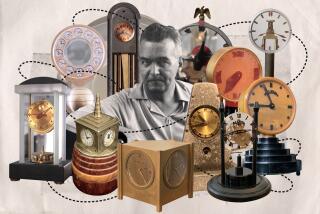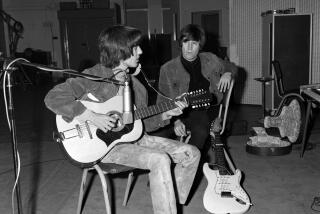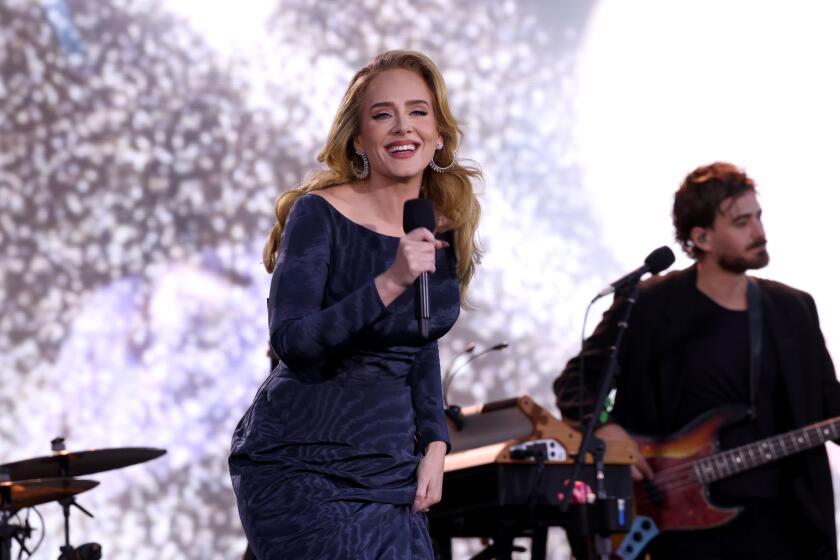Plugged in to Bob Dylan’s guitar
On July 25, 1965, Bob Dylan stepped onstage at the Newport Folk Festival, plugged in an electric guitar and changed the course of pop music history.
The performance caused a furious reaction. The crowd booed loudly, and folk icon Pete Seeger tried to stop the show. Dylan and his band retreated after three songs, coming back to play an acoustic set. Still, Dylan’s provocative move has long been pointed to as a key moment when electric rock music eclipsed folk as the sound of the ‘60s generation.
“It was a changing point not only in music but in pop culture,” said Andy Babiuk, an authority on vintage rock music instruments and equipment. “You think about it now — seeing him play ‘Like a Rolling Stone’ in 1965 — wouldn’t that be the best thing ever? But at the moment it’s devastating: People are booing him; Pete Seeger says ‘Unplug him.’ The fact of him electrifying it makes it so important. He was telling the world, ‘No, this is how I’m doing it now.’”
PHOTOS: Iconic rock guitars and their owners
But whatever became of the guitar itself, a 1964 sunburst Fender Stratocaster?
A new PBS television documentary contends that the instrument was left by Dylan in a private plane and has been stored in an East Coast attic for nearly 50 years.
Dylan’s attorney, however, issued a statement Wednesday claiming that the guitar Dylan played at Newport remains in the artist’s possession, though acknowledging that similar guitars owned by Dylan in the mid-’60s have fallen into other hands.
Beyond the controversy, what’s undeniable is that Dylan’s guitar has kept an astonishingly low profile since it helped turned the music world inside out nearly half a century ago — unlike other legendary instruments, including Eric Clapton’s “Blackie” Stratocaster that sold at auction for nearly $1 million, the Strat that Jimi Hendrix set aflame at the 1967 Monterey Pop Festival and the guitars the Beatles played on the Ed Sullivan show.
That’s partly because Dylan was never considered a guitar hero, and partly because “Bob didn’t care,” said Jonathan Taplin, a former tour manager for Dylan and the Band who now is director of USC’s Annenberg Innovation Lab.
“Bob wasn’t a lead guitar player; he was a musician,” Taplin said. “It wasn’t like the days when Clapton would have these really expensive guitars made to his exact specifications. This was literally an off-the-shelf guitar from Manny’s Music in New York, which is where [Dylan’s then-manager] Albert Grossman had an account, so that’s where everybody would get their equipment when they needed anything.”
Now, however, the PBS series “History Detectives” thinks it knows what became of the famous ax. In a segment to premiere Tuesday, July 17, the show examines the claim of Dawn Peterson, a 43-year-old New Jersey woman whose late father, Vic Quinto, was a pilot who flew Dylan and other artists to gigs back in the 1960s.
Peterson told the show’s producers that Quinto, who died in 1977, had always said the Newport electric guitar had been inadvertently left on his plane. She said he had tried without success to notify Dylan’s camp in attempting to return the guitar to him.
“Since I can remember a guitar had been in the attic, although no one, including me, paid much attention to it,” Peterson said in an email to The Times on Wednesday.
Peterson, who was 8 when her father died, said the instrument “remained in my mother’s attic for another 20 years until I got married and brought it to my home. As far as the Dylan Newport Folk Festival connection, we didn’t know for sure until the ‘History Detectives’ completed their work.”
The show consulted rock historians and music experts, and concluded that it was likely the genuine article, based on several factors.
It was in a guitar case stenciled with the words “Property of Ashes & Sand Inc.,” the name of the touring company Dylan used at the time, but which was little known outside his inner circle. The case also contained several pages of song lyrics, which Dylan manuscript collector Jeff Gold judges to be authentic “beyond a shadow of a doubt.”
Peterson also produced her father’s address book with a phone number of Dylan’s home in Woodstock, N.Y.; and through comparisons with recently uncovered high-quality color photos of Dylan’s performance at Newport, Babiuk cited matching wood grain marks on the guitar’s body and its neck to determine it was the same as the guitar used in Newport. “I’d stake my reputation on it,” he told The Times.
Elyse Luray, one of the hosts of the PBS show, noted that the producers frequently are unable to verify claims of treasures found in attics.
“I’ve been in the memorabilia business for a long time, I worked for Christie’s [auction house], and we’d always have people come in with something their parents told them was significant, but it’s not the case,” Luray said. “It was great to actually make the connections with this guitar. It’s almost like finding the Holy Grail ofrock ‘n’ rollmemorabilia.”
Or maybe not.
“Bob has possession of the electric guitar he played at the Newport Folk Festival in 1965,” Dylan attorney Orin Snyder said in an email to The Times on Wednesday. “He did own several other Stratocaster guitars that were stolen from him around that time, as were some handwritten lyrics. In addition, Bob recalls driving to the Newport Folk Festival, along with two of his friends, not flying.”
A “History Detectives” spokesman said the program stood by its report, which airs Tuesday, noting that “Babiuk has previously authenticated numerous guitars including a John Lennon Gretsch 6120 currently on display at the Rock and Roll Hall of Fame, and a Bob Dylan Hummingbird used by Mr. Dylan at President Bill Clinton’s inauguration. ‘History Detectives’ welcome the opportunity to examine the guitar which is currently in Mr. Dylan’s possession.”
Whatever the provenance of Peterson’s guitar, it wouldn’t be unusual for a guitar owned even by someone as famous as Bob Dylan to go missing in action.
Peter Frampton’s Gibson electric guitar, a portion of which is pictured on the cover of his blockbuster 1976 album “Frampton Comes Alive,” was presumed destroyed in a 1980 cargo plane crash in Venezuela but was located a couple of years ago on the Dutch island of Curacao and returned to the British rocker earlier this year.
A Stratocaster that Hendrix once gave to ZZ Top guitarist Billy Gibbons was stolen, only to turn up years later in a pawn shop. The man who had bought it for $300 recognized it after reading of Gibbons’ loss and returned it to him.
Peterson, for her part, said she knows little about the guitar in question besides the family story that it was left on the plane.
She said she has no plans to sell it.
More to Read
The biggest entertainment stories
Get our big stories about Hollywood, film, television, music, arts, culture and more right in your inbox as soon as they publish.
You may occasionally receive promotional content from the Los Angeles Times.










